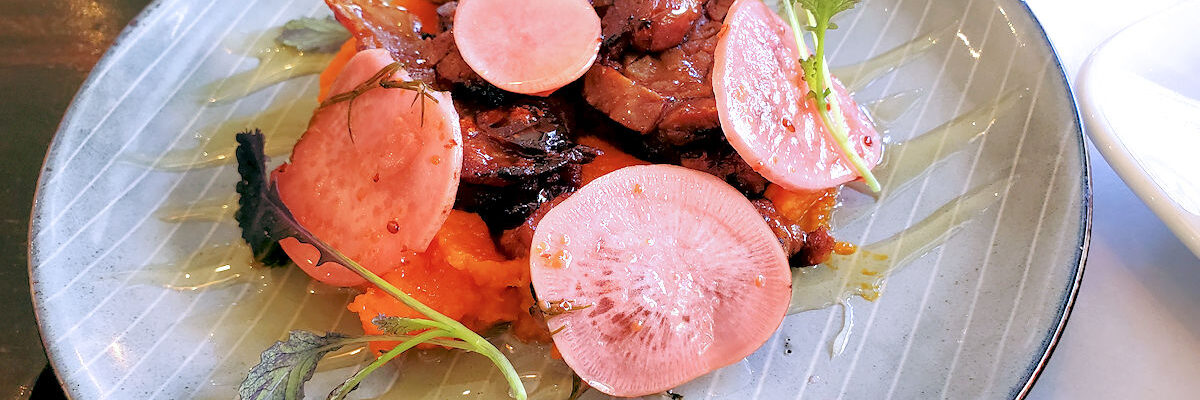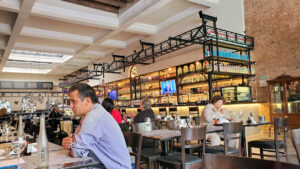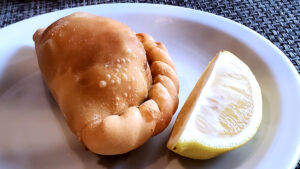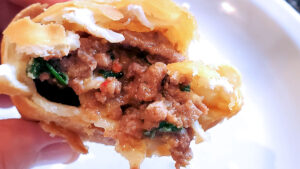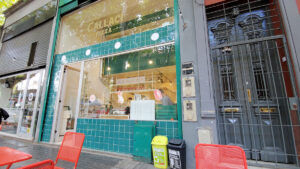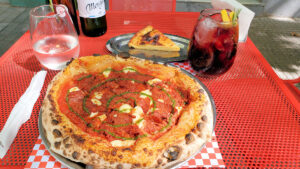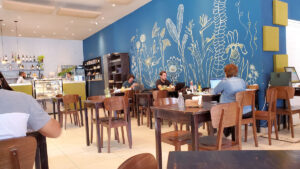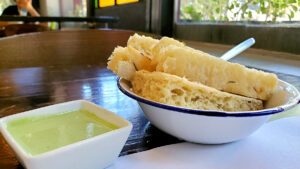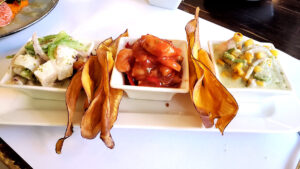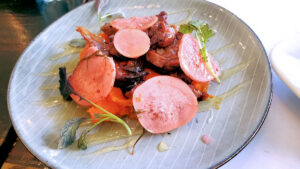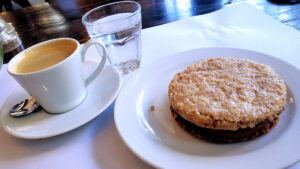History. Yes, today, in Bite Marks, we’ll get a bit of history.
It was 1896 when El Tropezón first opened its doors as a local Spanich cuisine eatery. Given its proximity to the Congreso, it became a hotspot for the politicos of the era. Famous for its puchero, a classic Spanish stew, it was even immortalized in a tango song of the era, Marche un Pucherito de Gallina. Originally a small corner spot, intimate, at Callao and Bartolomé Mitre, it became popular enough that in short order, in 1902, it moved to larger quarters on Cangallo (now Tte. Gnrl. Juan D. Perón) in the Hotel Callao.
There it remained for a couple of decades, until one day in 1926, out of the blue, the hotel simply collapsed, burying the restaurant under a pile of rubble. Somehow, apparently, no one was killed in either the hotel or restaurant (which begs the description of a “pile of rubble”). The owners re-opened nearby at Av. Callao 248, where it remained an icon of upper crust nightlife until closing its doors in 1983, during the military dictatorship.
Taken over by the government, it was repurposed into a branch of the post office, and remained so until not so many years ago when it was bought and “restored”, though with a completely new decor, re-opening under the El Tropezón name in 2017. The menu, apparently, remains fairly similar to what was offered “back in the day”, and sticks with a price level that’s more in line with those with a fat wallet. One is greeted, today, with a slightly stiff head to toe glance-over by a doorman, and then greeted cordially once passed through the door by the hovering waitstaff.
There’s nothing majorly creative on the menu, just straightforward classic cooking of both Argentine and Spanish origin. May as well start with the one empanada offering they have, the carne, or beef, which, I have to admit, for a place of this stature, did offer a mild surprise in that the filling is made with ground beef, rather than chopped steak. It’s good, nicely seasoned, but nothing special, given the 295 peso price-tag.
Being a solo luncher, I wasn’t about to order up the famed puchero, instead turning to simple midday fare and a milanesa. Interestingly, instead of the usual choices of fries, mashed potato, or salad, the milanesa here is served with pappardelle pasta tossed in butter and grated cheese. A nice twist, and for me, preferred to potatoes. I do wish the milanesa was far, far better, even setting aside its 1990 peso wallet hit. It’s small, it’s paper thin, the breading is flavorless, and it was drenched in oil. The pasta, thankfully, was quite good, and I focused on that.
Service was friendly. Not totally free of mistakes – my waiter first brought simply a plate of pappardelle (a la putanesca), as he’d not registered the milanesa part. He looked for a moment like he was going to argue the point, but didn’t. On the other hand, in hindsight, I might have had a better meal just eating that. The place is pricey. To the above, tack on 430 pesos for a glass of lemonade, and 230 pesos for a cubierto charge, and with tip we’re at 3250 pesos for a pretty basic empanada and milanesa lunch. I’ve can get better of both, in any neighborhood in the city, for half the price. So, other than for a vaguely historical value and exploration’s sake, I can’t say that I recommend the place.
Moving swiftly to the other end of history, one of a spate of new pizzerias that opened up during the pandemic. Initially opened as a strictly delivery service, Calacci Pizza, has found a home at Castillo 720 in Villa Crespo. It has quickly developed a bit of a cult following as the two Calacce brothers turn out what were reputed to be excellent, creative pizzas. Every day but Monday they’re open for dinner service only, with the addition of now being open on Saturdays for lunch. Although scheduled for an opening hour of 1pm, at 1:15 they weren’t set up for service, and seemed to be cleaning up from the night before. I took a walk around the ‘hood for half an hour and came back to find them setting up the tables and chairs, and, albeit I was the first person seated, within about 20 minutes every table was filled, mostly with folk who had clearly been there before and knew the timing score.
The menu only offers an individual sized pizza, though being a full 12″ sized pie, that’s a lot of pizza for one person. Especially as each person is also gift a portion of fainá. This is, however, really, really good pizza. The crust one of the better ones I’ve had, the sauce flavorful and plentiful. I had ordered the Diavola, with pepperoni and fresh mozzarella, and they delivered, particularly the former. Rather than cutting the pepperoni into rounds, they thinly shave it, liberally covering the entire pizza with multiple layers of sausage. I shock myself by saying it could have used more cheese, since the over abundance of mozzarella on most pizzas here is a pet peeve, but this could have done with a bit more. The pepperoni, however, is glorious, and spicy, and the slight herbal note offered by the pesto puree swirled atop just added a whole dimension to the flavor. Paired with a glass of vermouth and soda. Respectively, 1020 pesos for the pizza, and 450 for the vermouth, plus a bottle of water (150) and tip, a delightful, and filling, pizza lunch for, well, 1620, as they offer a 10% discount for cash, so I just paid in full leaving the discount as the tip.
I’ve walked past this place numerous times since it opened, it happens to be near to my doctor’s office. I had a little free time before an appointment and decided to venture inside of Selena, Honduras 3993, Palermo for a quick lunch. It’s bright and airy, tables are spread far apart, service is quick and friendly, it has sort of the feel of a café, but one that offers creative cooking. The menu is moderately extensive. I decided on two appetizers.
First, the bread. Delightful, pillow soft focaccia, which could have used maybe another couple of minutes to brown, but a perfect canvas for the rocking good cilantro sauce.
The trio of ceviches had caught my eye before ever entering – offering one each of “classic” Peruvian, Mexican, and Venezuelan ceviches. They’re good. I wouldn’t go further than that. They’re each quite different. The Peruvian one with cubes of fish and peppers in a lime juice cure, however the peppers aren’t chilies, I think they were probably Italian frying peppers, so although a nice balance of acid and salt, there was no heat. The Mexican one was shrimp in a very tomato-y, almost barbecue-like sauce. Again, tasty, but no heat, and I can’t recall ever encountering a Mexican ceviche like that. Also, the shrimp were overcooked and rubbery. The same two faults carried over into the Venezuelan one with the same shrimp, with corn, and again, nothing picante. So, interesting, but not really a winner in my book. 950 pesos.
On the other hand, the crispy, caramelized sweetbreads with pickled radishes and a sweet potato puree, were a winning combination. A touch more salt in the puree, which had absorbed a fair amount of the lime juice squeezed over it, would be in order. The drizzle of coriander infused honey over the whole thing gave it a nice balance. And, at 860 pesos, a far more satisfying dish.
I hadn’t planned to have anything more, but I still had a few minutes to spare, so I ordered up one of the excellent house made alfajores, made with almond cookies and a dulce de leche filling, and a quite good coffee. 300 and 190 pesos, respectively.
Another spot that charges a cubierto, unusual for new restaurants here, since it’s kind of passé to do so. All told, 2680 pesos plus tip. Still coming in below the average empanada and milanesa at the top of the page.
More to come, but this seems a good stopping place for today!
